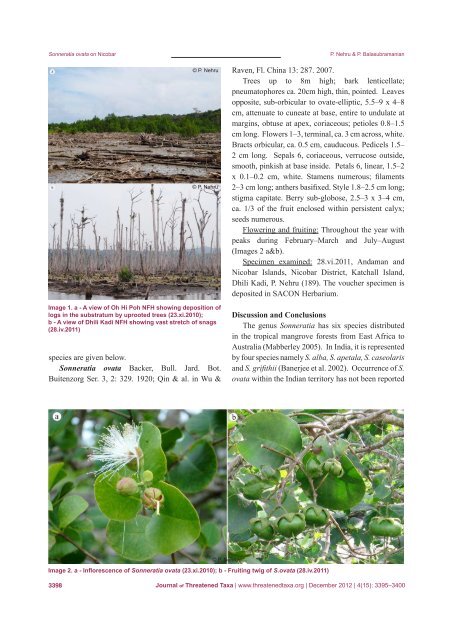December 2012 - Journal of Threatened Taxa
December 2012 - Journal of Threatened Taxa
December 2012 - Journal of Threatened Taxa
Create successful ePaper yourself
Turn your PDF publications into a flip-book with our unique Google optimized e-Paper software.
Sonneratia ovata on Nicobar<br />
P. Nehru & P. Balasubramanian<br />
© P. Nehru<br />
© P. Nehru<br />
Image 1. a - A view <strong>of</strong> Oh Hi Poh NFH showing deposition <strong>of</strong><br />
logs in the substratum by uprooted trees (23.xi.2010);<br />
b - A view <strong>of</strong> Dhili Kadi NFH showing vast stretch <strong>of</strong> snags<br />
(28.iv.2011)<br />
species are given below.<br />
Sonneratia ovata Backer, Bull. Jard. Bot.<br />
Buitenzorg Ser. 3, 2: 329. 1920; Qin & al. in Wu &<br />
Raven, Fl. China 13: 287. 2007.<br />
Trees up to 8m high; bark lenticellate;<br />
pneumatophores ca. 20cm high, thin, pointed. Leaves<br />
opposite, sub-orbicular to ovate-elliptic, 5.5–9 x 4–8<br />
cm, attenuate to cuneate at base, entire to undulate at<br />
margins, obtuse at apex, coriaceous; petioles 0.8–1.5<br />
cm long. Flowers 1–3, terminal, ca. 3 cm across, white.<br />
Bracts orbicular, ca. 0.5 cm, cauducous. Pedicels 1.5–<br />
2 cm long. Sepals 6, coriaceous, verrucose outside,<br />
smooth, pinkish at base inside. Petals 6, linear, 1.5–2<br />
x 0.1–0.2 cm, white. Stamens numerous; filaments<br />
2–3 cm long; anthers basifixed. Style 1.8–2.5 cm long;<br />
stigma capitate. Berry sub-globose, 2.5–3 x 3–4 cm,<br />
ca. 1/3 <strong>of</strong> the fruit enclosed within persistent calyx;<br />
seeds numerous.<br />
Flowering and fruiting: Throughout the year with<br />
peaks during February–March and July–August<br />
(Images 2 a&b).<br />
Specimen examined: 28.vi.2011, Andaman and<br />
Nicobar Islands, Nicobar District, Katchall Island,<br />
Dhili Kadi, P. Nehru (189). The voucher specimen is<br />
deposited in SACON Herbarium.<br />
Discussion and Conclusions<br />
The genus Sonneratia has six species distributed<br />
in the tropical mangrove forests from East Africa to<br />
Australia (Mabberley 2005). In India, it is represented<br />
by four species namely S. alba, S. apetala, S. caseolaris<br />
and S. grifithii (Banerjee et al. 2002). Occurrence <strong>of</strong> S.<br />
ovata within the Indian territory has not been reported<br />
© P. Nehru<br />
Image 2. a - Inflorescence <strong>of</strong> Sonneratia ovata (23.xi.2010); b - Fruiting twig <strong>of</strong> S.ovata (28.iv.2011)<br />
3398<br />
<strong>Journal</strong> <strong>of</strong> <strong>Threatened</strong> <strong>Taxa</strong> | www.threatenedtaxa.org | <strong>December</strong> <strong>2012</strong> | 4(15): 3395–3400

















